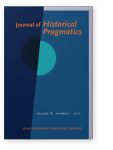Vol. 18:1 (2017) ► pp.58–81
Descriptive and diachronic aspects of the Old Irish quotative marker ol
The most frequent strategy of direct reported speech in Old Irish (OIr) is characterized by the use of a constituent which is known in this paper as Reported Speaker, which consists of the element ol introducing the noun or the tonic pronoun referring to the person whose words are quoted. This paper offers a formal and pragmatic description of the Old Irish Reported Speaker, paying special attention to its basically nominal character and to its frequent coreferential association with first-person referents in the quote. The OIr quotative marker ol is diachronically explained as a further use of the OIr multifunctional element ol, which is essentially a preposition (‘beyond’) secondarily used as the marker of the NP standard of comparison and as a clausal connective.
Article outline
- 1.Introduction
- 2.Formal constituency of the OIr Reported Speaker
- 2.1The OIr quotative particle ol and its formal variants
- 2.2The NP of the OIr RS
- 2.3The pronominal reference of the OIr RS
- 2.4The nominal nature of the OIr RS
- 3.Syntactic and pragmatic features of the OIr RS
- 3.1The place of the OIr RS within the sentence
- 3.2Pronominal coreference of vocative and RS in OIr
- 3.3Summary of the descriptive analysis of the OIr RS
- 4.OIr ol as a multifunctional morpheme
- 4.1The OIr forms ol
- 4.2The OIr prepositions ol and ar as multifunctional elements
- 5.On the origin of the OIr RS constituent
- 5.1Previous research
- 5.2The present diachronic explanation
- 5.3On the OIr preposition ar (‘for, as regards’) as quotative marker
- 5.4Evaluation of the diachronic hypothesis for the OIr RS
- 6.Conclusion
- Acknowledgements
- Notes
- Sources
-
References
This article is currently available as a sample article.
